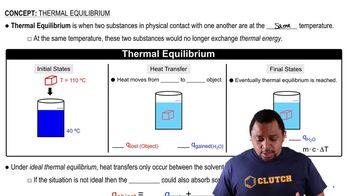A 5.55-g sample of a weak acid with Ka = 1.3⨉10-4 was combined with 5.00 mL of 6.00 M NaOH, and the resulting solution was diluted to 750.0 mL. The measured pH of the solution was 4.25. What is the molar mass of the weak acid?
Ch.18 - Aqueous Ionic Equilibrium

Chapter 18, Problem 126
If the sodium concentration in blood plasma is 0.140 M, and Ksp for sodium urate is 5.76 * 10^-8, what minimum concentration of urate would result in precipitation?
 Verified step by step guidance
Verified step by step guidance1
Identify the chemical equilibrium involved: NaC5H3N4O3 (s) ⇌ Na^+ (aq) + C5H3N4O3^- (aq).
Write the expression for the solubility product constant (K_{sp}): K_{sp} = [Na^+][C5H3N4O3^-].
Substitute the given values into the K_{sp} expression: 5.76 \times 10^{-8} = (0.140)[C5H3N4O3^-].
Solve for the concentration of urate ion, [C5H3N4O3^-], by dividing K_{sp} by the sodium ion concentration: [C5H3N4O3^-] = \frac{5.76 \times 10^{-8}}{0.140}.
Interpret the result: The calculated [C5H3N4O3^-] is the minimum concentration of urate required for precipitation to occur.
Key Concepts
Here are the essential concepts you must grasp in order to answer the question correctly.
Solubility Product Constant (Ksp)
The solubility product constant (Ksp) is an equilibrium constant that applies to the solubility of ionic compounds. It represents the maximum product of the molar concentrations of the ions in a saturated solution at a given temperature. For sodium urate, Ksp indicates the point at which the solution becomes saturated, and any additional solute will precipitate out of the solution.
Recommended video:
Guided course

Solubility Product Constant
Precipitation Reaction
A precipitation reaction occurs when two soluble salts react in solution to form an insoluble product, or precipitate. In this context, when the concentration of urate ions exceeds a certain threshold, determined by the Ksp, sodium urate will begin to form solid crystals, indicating that the solution is supersaturated with respect to that compound.
Recommended video:
Guided course

Selective Precipitation
Equilibrium Concentrations
Equilibrium concentrations refer to the concentrations of reactants and products in a chemical reaction at equilibrium. In the case of sodium urate, the equilibrium expression derived from Ksp allows us to calculate the minimum concentration of urate ions needed to reach the saturation point, where the product of the concentrations of sodium and urate equals the Ksp value.
Recommended video:
Guided course

Thermal Equilibrium
Related Practice
Textbook Question
Textbook Question
Pseudogout, a condition with symptoms similar to those of gout (see Problem 126), is caused by the formation of calcium diphosphate (Ca2P2O7) crystals within tendons, cartilage, and ligaments. Calcium diphosphate will precipitate out of blood plasma when diphosphate levels become abnormally high. If the calcium concentration in blood plasma is 9.2 mg/dL, and Ksp for calcium diphosphate is 8.64⨉10-13, what minimum concentration of diphosphate results in precipitation?
Textbook Question
Calculate the solubility of silver chloride in a solution that is 0.100 M in NH3.
Textbook Question
Calculate the solubility of CuX in a solution that is 0.150 M in NaCN. Ksp for CuX is 1.27⨉10-36.
